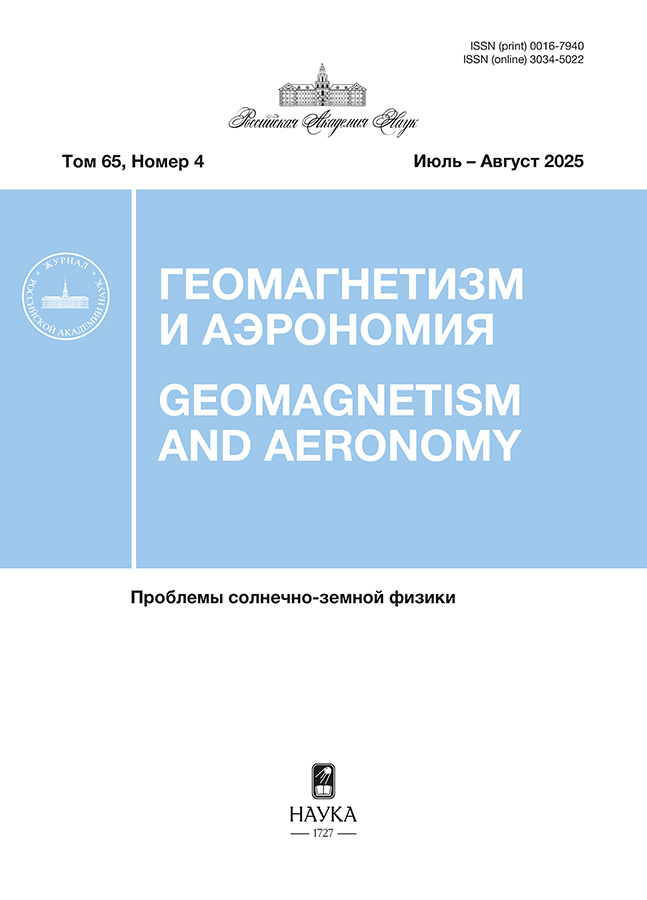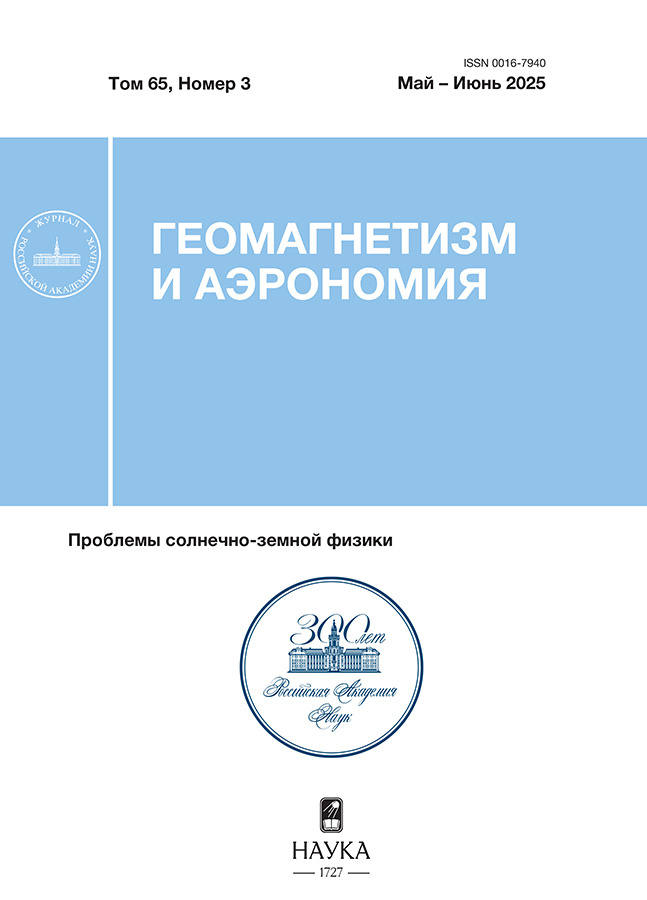Связи между индексами солнечной активности в разные интервалы времени
- Авторы: Деминов М.Г.1
-
Учреждения:
- Институт земного магнетизма, ионосферы и распространения радиоволн им. Н.В. Пушкова РАН
- Выпуск: Том 65, № 3 (2025)
- Страницы: 335-342
- Раздел: Статьи
- URL: https://cijournal.ru/0016-7940/article/view/686968
- DOI: https://doi.org/10.31857/S0016794025030041
- EDN: https://elibrary.ru/ESCRAE
- ID: 686968
Цитировать
Полный текст
Аннотация
Представлены результаты анализа долговременных изменений связи между индексами солнечной активности за 1953−2023 годы. Для этого использованы скользящие средние за год индексы F10, F30, MgII, Ri и T – потоки радиоизлучения Солнца на длинах волн 10.7 и 30 см, отношение центральной части к флангам в полосе излучения магния 276–284 нм, международное число солнечных пятен и ионосферный индекс, который определен по ионосферным данным как аналог числа солнечных пятен. Получено, что весь период измерений можно разделить на интервалы 1953−1980, 1981−2012 и 2013−2023 гг., в которых связи между индексами солнечной активности отчетливо различаются. В интервале 1953−1980 гг. эти связи стабильны, т.е. линейный по времени тренд в зависимости одного индекса солнечной активности от другого практически отсутствует. В интервале 2013−2023 гг. такие тренды обычно значимы. Границы этих интервалов (1980 и 2013 г.) примерно соответствуют максимумам первого и последнего солнечных циклов в режиме понижающейся активности, когда происходит уменьшение со временем крупномасштабного магнитного поля Солнца и высоты солнечного цикла. Следовательно, связи между индексами солнечной активности, включая связи между ионосферным индексом и солнечными индексами, дают дополнительную информацию об изменении режимов солнечных циклов и могут служить одной из характеристик изменения этих режимов.
Ключевые слова
Полный текст
Об авторах
М. Г. Деминов
Институт земного магнетизма, ионосферы и распространения радиоволн им. Н.В. Пушкова РАН
Автор, ответственный за переписку.
Email: deminov@izmiran.ru
Россия, Троицк
Список литературы
- Обридко В.Н. Магнитные поля и индексы активности / Пламенная гелиогеофизика, 2 т. / Ред. Л.М. Зеленый и И.С. Веселовский. М.: Физматлит. T. 1. С. 41−60. 2008.
- Обридко В.Н., Шельтинг Б.Д. Некоторые аномалии эволюции глобальных и крупномасштабных магнитных полей на Солнце как предвестники нескольких предстоящих невысоких циклов // Письма в Астрономический журнал. Т. 35. № 4. С. 279–285. 2009.
- Balogh A., Hudson H.S., Petrovay K., von Steiger R. Introduction to the solar activity cycle: Overview of causes and consequences // Space Sci. Rev. V. 186. № 1–4. P. 1–15. 2014. https://doi.org/ 10.1007/s11214-014-0125-8
- Caruana J. The IPS monthly T index / Proc. Solar-Terrestrial Prediction Workshop. Leura, Australia. October 16–20, 1989. V. 2. Ed. R.J. Thompson. Boulder, CO: Environmental Research Lab. P. 257–263. 1990.
- Danilov A.D., Berbeneva N.A. Statistical analysis of the critical frequency foF2 dependence on various solar activity indices // Adv. Space Res. V. 72. № 6. P. 2351–2361. 2023. https://doi.org/10.1016/j.asr.2023.05.012
- Danilov A.D., Konstantinova A.V. Trends in foF2 to 2022 and various solar activity indices // Adv. Space Res. V. 71. № 11. P. 4594–4603. 2023. https://doi.org/10.1016/j.asr.2023.01.028
- Harvey K.L. The cyclic behavior of solar activity / The Solar Cycle. Proc. National Solar Observatory / Sacramento Peak 12th Summer Workshop / Astr. Soc. P. V. 27. Ed. K.L. Harvey. San Francisco: ASP. P. 335–367. 1992.
- Hathaway D.H. The solar cycle // Living Rev. Sol. Phys. V. 12. ID 4. 2015. https://doi.org/10.1007/lrsp-2015-4
- Laštovička J., Burešova D. Relationships between foF2 and various solar activity proxies // Space Weather. V. 21. № 4. ID e2022SW003359. 2023. https://doi.org/10.1029/2022SW003359
- Laštovička J. Dependence of long-term trends in foF2 at middle latitudes on different solar activity proxies // Adv. Space Res. V. 73. № 1. P. 685–689. 2024. https://doi.org/10.1016/j.asr.2023.09.047
- Livingston W., Penn M.J., Svalgaard L. Decreasing sunspot magnetic fields explain unique 10.7 cm radio flux // Astrophys. J. Lett. V. 757. № 1. ID L8. 2012. https://doi.org/10.1088/2041-8205/757/1/L8
- Martin S.F. Observations key to understanding solar cycles: a review // Front. Astron. Space Sci. V. 10. ID 1177097. 2024. https://doi.org/10.3389/fspas.2023.1177097
- Mursula K., Pevtsov A.A., Asikainen T., Tahtinen I., Yeates A.R. Transition to a weaker Sun: Changes in the solar atmosphere during the decay of the Modern Maximum // Astron. Astrophys. V. 685. ID A170. 2024. https://doi.org/10.1051/0004-6361/202449231
- Petrie G.J.D. Global solar photospheric and coronal magnetic field over activity cycles 21–25 // J. Space Weather Space. V. 14. ID 5. 2024. https://doi.org/10.1051/swsc/2024005
- Rees M.H. Physics and chemistry of the upper atmosphere. New York: Cambridge Univ. Press, 289 p. 1989.
- Svalgaard L., Hansen W.W. Solar activity – past, present, future // J. Space Weather Space. V. 3. ID A24. 2013. https://doi.org/10.1051/swsc/2013046
Дополнительные файлы














